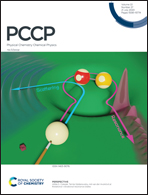Mechanism of powellite crystallite expansion within nano-phase separated amorphous matrices under Au-irradiation†
Abstract
A fundamental approach was taken to understand the implications of increased nuclear waste loading in the search for new materials for long-term radioisotope encapsulation. This study focused on the formation and radiation tolerance of glass ceramics with selectively induced CaMoO4 as a form to trap the problematic fission product molybdenum. Several samples were synthesised with up to 10 mol% MoO3 within a soda lime borosilicate matrix, exhibiting phase separation on the nano scale according to thermal analysis, which detected two glass transition temperatures. It is predicted that these two phases are a result of spinodal decomposition with Si–O–Ca–O–Si and Si–O–Ca–O–B units, with the latter phase acting as a carrier for MoO3. The solubility limit of molybdenum within this matrix was 1 mol%, after which crystallisation of CaMoO4 occurred, with crystallite size (CS) increasing and cell parameters decreasing as a function of [MoO3]. These materials were then subjected to irradiation with 7 MeV Au3+ ions to replicate the nuclear interactions resulting from α-decay. A dose of 3 × 1014 ions per cm2 was achieved, resulting in 1 dpa of damage within a depth of ∼1.5 μm, according to TRIM calculations. Glasses and glass ceramics were then analysed using BSE imaging, XRD refinement, and Raman spectroscopy to monitor changes induced by accumulated damage. Irradiation was not observed to cause any significant changes to the residual amorphous network, nor did it cause amorphisation of CaMoO4 based on the relative changes to particle size and density. Furthermore, the substitution of Ca2+ to form water-soluble Na2/NaGd–MoO4 assemblages did not occur, indicating that CaMoO4 is resilient to chemical modification following ion interactions. Au-irradiation did however cause CaMoO4 lattice parameter expansion, concurrent to growth in CS. This is predicted to be a dual parameter mechanism of alteration based on thermal expansion from electronic coupling, and the accumulation of defects arising from atomic displacements.



 Please wait while we load your content...
Please wait while we load your content...